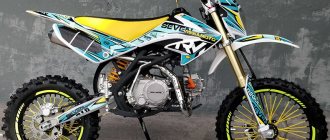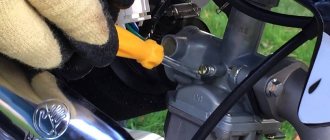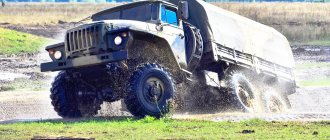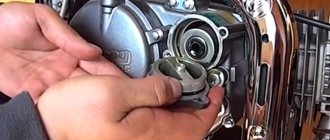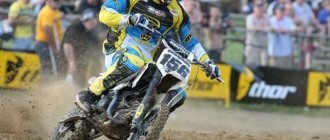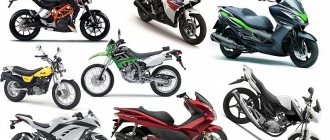A pitbike is a small, lightweight motorcycle that looks like a cross-country off-road unit. It has a 4-stroke engine and wheels with sizes of 10, 12, 14 and 17 inches. They are produced by many motorcycle manufacturers, both world leaders and smaller companies. Today you can buy it in almost every more or less large city from official dealers of companies.
Mini motorcycles of this type are suitable for people weighing up to 100 kg. To make it comfortable to drive, it is equipped with a reinforced frame, extended wheelbase, reinforced suspension, high handlebars, etc. However, it remains an oversized bike, which makes it a real pleasure to ride. The fuel used is 92nd or 93rd grade gasoline, which is simply poured into the gas tank. There is no need to add or mix oil with additives into gasoline, which also simplifies the preparation of the bike for travel and operation.
The main questions are how to ride and where? Country - movement over rough terrain. 10-17-inch wheels with off-road tread are suitable for this. Country skiing is the most popular type of skiing. The main thing is to protect the rider.
Motocross. Any tracks and jumps for riding and jumping are suitable for this. Wheels must be 14/12 or 17/14 inches equipped with off-road tires. All attention is paid to the safety of the rider.
Supermoto involves riding on any flat surface. Karting track or special tracks for Supermoto are perfect for this. Wheels can be 12/12 or 14/14 inches, and Slick tires provide good grip.
Stunt is one of the most popular disciplines. Any area with a smooth, high-quality surface is suitable for it. Involves performing various stunts and basic aerobatics in motorsports. For best results, use pegs and yokes.
The park is a fairly new area that involves tricks and figures. You can ride in Skate and BMX parks, specially created for this purpose. A pit bike in this discipline weighs quite a bit. Wheels with road tires should be 12/12 inches. Motorcycle protection is provided by pegs and sliders.
Freestyle motocross is also a new discipline. These are dizzying jumps from springboards, performing acrobatic stunts in flight. But this is also the most dangerous direction.
Street is driving around the city without rules and restrictions. Various tricks are performed on obstacles. Obstacles include stairs, curbs, walls, cars - any objects protruding or rising above the asphalt. Motorcycle protection is provided with pegs, yokes, and sliders. But this discipline is prohibited because it is dangerous for the drivers themselves and others.
There is a question that interests both the owners of a new pit bike and those who are just planning to buy one: is it dangerous? Riding a minibike is safe if you don’t forget about protection and use common sense rather than passion. If you do the opposite, then not only a motorcycle, but also a bicycle, but also a scooter will become dangerous.
Pitbike has a simple, but at the same time reliable design, the operation of which does not require the driver to have special knowledge or certain skills.
In order for the bike to serve you for a long time and not cause any complaints, you need to properly break it in and monitor the condition of the parts and components. Attention should be paid to the quality of movement from the first ride until the completion of the first 35 motorcycle hours.
During break-in, pay attention to the engine. In order to continue to enjoy a good and fast ride, you first need to be patient. Carefully monitor the oil level in the engine using the dipstick. When checking, the motorcycle must be level, otherwise the indicator will be overestimated or underestimated. Unscrew the dipstick, wipe it with a clean cloth, insert it back without screwing it in, then take it out again and look.
The oil level can also be checked on a “hot engine”. After turning off the engine, you need to wait a couple of minutes and then take measurements.
When running the motorcycle for the first 35 hours, strictly ensure that the engine does not overheat. When starting a cold engine, wait until it warms up (approximately 2 minutes).
To make the run-in as effective as possible, follow the recommendations. Avoid sudden and heavy loads on the engine and clutch. Do not ride for a long time at low speeds, pick up speed smoothly. When changing speeds, avoid jolts and jerks, change gear modes smoothly. On each subsequent trip, if the break-in was done correctly, the gearbox will work more clearly, and gear shifting will become more confident. To ensure the engine lasts longer, the oil should be changed twice during break-in: after 18 and 35 hours of operation.
www.micromoto.ru
Preparation
An important parameter for success in shifting gears is the speed and accuracy with which you shift, so you need to carefully consider the issue of convenient location of the clutch lever and the height of the gearbox foot. Both parameters depend entirely on your riding position and may change as you gain experience riding the motorcycle. The fingers of your left hand should not rest on the clutch lever, you should touch the lever only when changing gear, the rest of the time your hand should clasp the steering wheel clip. You must choose the angle of the clutch lever and its lift in such a way that you can reach the lever at any time and nothing will interfere with you. You need to pull the clutch lever with four fingers. Pay attention to this. It is not recommended to install shortened bicycle-type handles under two fingers.
- the lift of the lever is too large, there are times when you need to grab the steering wheel to reach the lever and this can only be done with your fingertips;
- The angle of the lever is such that it is not possible to reach the lever in all situations.
How to ride a pit bike around the city
- To avoid any complaints from the police, always wear a helmet while riding;
- Also follow the traffic rules;
- It's best to drive in the right lane, don't cut anyone off, never run a red light;
- To avoid getting an additional fine, try to drive at a speed of no more than 50 km/h, especially when passing police officers;
These basic rules will help you avoid fines from the police. You will also save your own health.
Start
The most difficult element for a beginner motorcyclist. Shift the gearbox to neutral. Make sure your elbows are bent and your center of gravity is forward. Depress the clutch. Engage first gear. From idle speed, smoothly release the clutch handle while raising the speed. If your motorcycle is equipped with a clutch lever position sensor (for example, Suzuki fuel-injected motorcycles), then you may notice how when starting from neutral the motorcycle itself adds speed - making it easier to start. Do not drop the clutch lever. Once you have mastered the soft start, you can learn to start faster. The principle of a fast start is the same as for a slow one - you load the front, your arms are bent, but the start does not start from idle speed, but from rpm from 4000 to 8000. The optimal start for a beginner in the city is to start from 3000 rpm. When starting, we recommend keeping your right foot on the rear brake - if you miscalculated the speed and the motorcycle begins to climb onto the rear wheel, use the rear brake. Often, we start where we end. Traction control when starting a motorcycle, using the rear brake, is widely used by riders when starting a motorcycle in world championships.
What is the benchmark - what is the fastest start. The fastest start is when you lie on the tank and throughout the entire acceleration line your wheel is torn off by 0.5 - 1 cm from the ground level. Taking into account bumps, this element is quite complex and, often, for its practical implementation, electronics are installed in motorcycles that control the unloading of the front wheel. On motorcycles equipped with a quick start, you can start with the throttle fully open; the electronics analyze the load on the front fork and automatically turn off the ignition as the fork becomes too unloaded. From the pilot's point of view, it looks like this: you load the front, lie down on the tank, fully unscrew the throttle and practically drop the clutch - the electronics do the rest. 99% of motorcycles are not equipped with a quick start and the pilot has to do the electronic work.
The main criterion for a successful start in the city is constant engine speed as the clutch releases. As you release the clutch, the revs begin to drop and you should try to keep the engine revs constant by opening the throttle at the same time as releasing the clutch. If you managed to do this, you can move on to the next step - reducing the clutch release time. After this exercise has begun to work out, try starting at high speeds, loading the front.
Shifting up gears with clutch
To understand the upshift technique, perform the following experiment. Drive in second gear with the throttle slightly turned off. Now, without closing the gas handle - squeeze the clutch - you will see how the revolutions instantly rise. Close the throttle. When the load in the form of the rear wheel disappears, nothing prevents the engine from spinning up and the speed increases rapidly. That is why speed in gear shifting plays an important role. If you shift quickly, then you may not close the throttle; at the moment when the clutch is depressed, the speed rises and immediately the gear shifts up and the clutch returns. If you do this quickly, then the revolutions rise by only 1000-1500 to provide optimal conditions for upshifting with the clutch.
To change gears up with the clutch, you need to quickly squeeze the clutch, shift up and release the clutch so that the revolutions at which the next gear is engaged do not exceed the revolutions of the gear from which you are shifting by more than 1500. If you do this slowly, you need to close the throttle at the moment when the clutch is depressed, if quickly, you can hold the handle in the same position or barely close the handle. An important criterion is the speed at which you started shifting up and the difference between the speed at which you depressed the clutch and at which you released the clutch - the difference should not exceed 1000 - 1500 revolutions. With practice, gear shifting will become automatic and will not require attention.
Memory
If you think riding a motocross bike is all about power, think again.
The mind plays a significant role here. A skill such as quickly assessing the situation and restoring it from memory is very helpful during the initial acquaintance with the track or the location of objects on the track.
It is for this reason that lazy riders make a lot of mistakes. Pre-race preparation and route assessment give you a better chance of winning the race than a driver who believes that speed is all it takes to finish first.
RPM at which you shift
You should shift up in the high rpm zone (cut-off rpm minus 4000). If you shift at low speeds, then you may need a larger throttle shift - 2000/3000. The technique for shifting at high speeds is the same for all motorcycles and displacements. The technique of switching at low speeds varies depending on the engine size by throttling. At low volumes, when switching at low speeds, more throttle is required than at large volumes. Shifting at low speeds is not correct.
What is a pit bike and what licenses are needed for it?
A pitbike is a small motorcycle that is somewhat reminiscent of a children's model. It requires rights and an appropriate category.
If the engine is on a pit bike, the volume of which is 50 cm3 or less, and the speed is no more than 50 km/h, then this vehicle will require a car license or a category “M” license.
A pit bike with an engine volume of 125 cm3 or more requires a motorcycle license with category “A”.
If you are going to drive around the city, then you need a license with open categories “A” and “B”. Under no circumstances should you drive without documents and insurance, because this is the vehicle that is most often stopped by police patrols.
Shifting without clutch
The motorcycle gearbox is designed in such a way that it allows you to shift up without a clutch at any speed. One way to shift up gears without a clutch is to briefly reduce traction using the throttle. You need to quickly close and open the throttle and at the same time push the gear shifter up. If you do this at the same time and quickly, the box will shift up without using the clutch. Another way is to use a quick switching device; a sensor connected to the ignition control unit is installed in the break of the switching foot rod. During an upshift, the rod presses on the sensor, the sensor transmits a command to the ignition control unit, and the unit turns off the ignition for a pre-programmed time depending on the engine speed (usually no more than 50 milliseconds), the motorcycle’s thrust drops and the box clicks up.
A little theory
RegulMOTO 125 cubes in gray design. In the video and further in the photo, this is exactly this technique.
The clutch on this pit bike is wet. This means that when you press the clutch handle while the speed is on, the rear wheel will spin! I was also surprised at first.
You can configure it in different ways. At first I was wildly infuriated by the fact that if I stalled and started to start with the electric starter, then the motorcycle wanted to leave me. You can set it so that it practically won’t leave, but it won’t rear up, and most likely will “ burn the clutch .”
Switch down
In order to understand what you should be wary of when shifting down, do a simple exercise: accelerate in second gear and completely close the throttle, while braking the engine, depress the clutch and roll with the clutch depressed, you will see that the engine speed will drop to idle, now, if you release the clutch there will be a sharp push, up to the temporary blocking of the rear wheel - the motorcycle will try to spin the engine from idle speed to the speed at which the motorcycle is currently moving. If you raise the speed when you release the clutch, the push will be less noticeable, and if the engine speed matches the speed at which the motorcycle is moving in second gear, there will be no jerk at all.
When you shift down, you must either do it quickly with the throttle closed in order to prevent the engine speed from dropping, or use over-throttle - i.e. add gas when shifting down.
All motorcycle speeds and its maximum speed
The maximum speed of a motorcycle depends on the power of the bike and the drive gear ratios. Motorcycles of different sizes can reach speeds from one hundred and forty kilometers to three hundred and forty kilometers per hour.
You don't need to make your bike's top speed an end in itself. Much more important is how dynamic your motorcycle is at all possible speeds. Gear ratios can be increased or decreased to improve the motorcycle's performance. For example, for city streets the maximum speed is not higher than 220 km/h. In this case, the gear ratios are selected so that at this speed the sixth gear is turned into the cutoff. The motorcycle will gain such important dynamics for it.
For track racing, the gear ratios are chosen slightly differently so that all six gears are used until a top speed of 280 kilometers per hour is achieved.
Replacing gear ratios is considered the cheapest tuning and does not affect the wear of the motorcycle.
www.motoking.ru
I quote Misha17:
“Tearing the box” is an interesting term.

